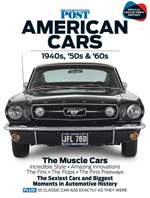 This article and other features about the golden era of American cars can be found in the Post’s Special Collector’s Edition, American Cars: 1940s, ’50s & ’60s.
This article and other features about the golden era of American cars can be found in the Post’s Special Collector’s Edition, American Cars: 1940s, ’50s & ’60s.
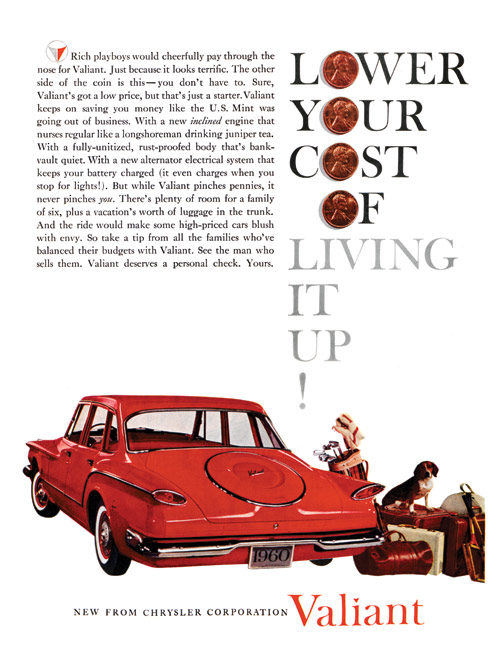
— Originally published October 15, 1960 —
The season just ended should go down in history as the year the automobile industry tried price-cutting — and found that it worked. The packages offered at the lower prices were smaller packages, to be sure; but for the first year since the war, the automakers offered something different from better and costlier caviar. They offered beans — and the beans sold very well. These more economical packages which found a larger-than-expected market were the so-called compact cars. They were the Ford Falcon and Comet, the Chrysler Valiant, and the General Motors Corvair. They had been preceded by two American Motors Ramblers and the Studebaker Lark.
In the first eight months of this calendar year, the combined production of these bargain items totaled 1.25 million — a surprising quarter-plus of the industry’s entire output. Compact is a difficult word. It was once described as “a Mormon expression meaning ‘a small automobile that won’t sell.’” This was a joking reference to a man named George Romney, and it now has a hollow ring. Romney, the head of American Motors, is a Mormon church official, and he builds smallish cars which he has always called compacts and which, for an agonizingly long time, sold very poorly. Now he is in a position to forgive any number of quips at his expense. He has collared more than 7 percent of the industry’s sales, and his pet word, compact, is so thoroughly in the public domain that Romney in private conversation won’t use it anymore. He calls compact cars “Rambler-size” cars.
a difficult word. It was once described as “a Mormon expression meaning ‘a small automobile that won’t sell.’”
Last season a compact was technically an automobile about a third lighter in weight, two feet shorter, a little narrower and lower, and with one-third less horsepower than similar specifications in standard low-priced automobiles. Original cost also was lower than the nearest standard make by as much as $300.
This season, slightly larger compacts have appeared. Pontiac has a Tempest which is a little larger than the 1960 compacts. Oldsmobile has the same-size car in its F-85, and Buick in its 1961 Special.
This represents a sharp altering of the market place. As late as 1958, a car buyer looking at all domestic automobiles offered would have to view five standard full-size brands before he ran into his first compact. This year, nearly every other car on the viewing list will be a compact.
It is very likely at this writing that the smaller cars grouped under the heading of Compact will capture at least one-third of all sales of American-produced cars in 1961. George Romney firmly predicts that the figure will reach 50 percent in 1961 and between 65 and 75 percent by 1963.
This need not necessarily be called a revolution, but at a minimum it is a very sharp change in automobile marketing patterns. At the most, it constitutes a shake-up so severe that it could wipe out or seriously change the character of some automobile brands that have had a fixed status for many years.
—“The ‘Compacts’ Are Here to Stay,” October 15, 1960
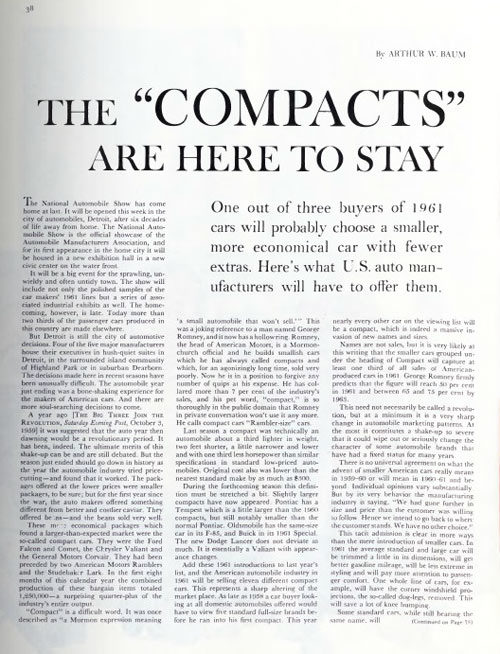
Become a Saturday Evening Post member and enjoy unlimited access. Subscribe now
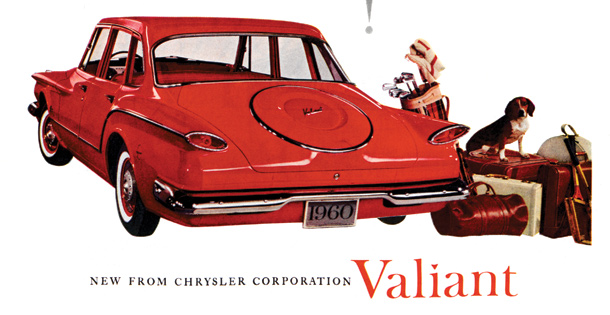
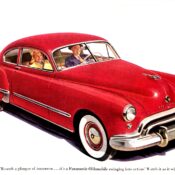
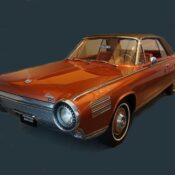

Comments
This is a really fascinating feature on the “Compacts” as they were just entering their 2nd model year, 1961. GM’s Tempest/LeMans, F-85 Cutlass and Skylark were slightly larger than the ’60 compacts. They were in fact, creating the ‘mid-size’ segment which (with the Malibu) would end GM’s true compacts by ’64 except for the retention of the Corvair and addition of the Chevy II/Nova in ’62.
Ford added the Fairlane for ’62 also as their Nova equivalent. I think as the ’60s went on, some of these compacts stole the spotlight and gradually took the fun out of the larger cars within the same car line. The 4th generation Ford T-Bird of 1964-’66 is a good example. Once the Mustang came out in ’64, the T-Bird lost its sporty style—-and convertible option with the ’67. It grew bigger and more Lincoln-like through ’76. Ford did keep the convertible option on the LTD through ’72, but its looks had become much more conservative.
With Chrysler, it’s a little harder to tell what happened in these respects to them with their car lines. The Chevelle/Malibu had really started encroaching in on the Impala, and then with the Camaro factor thrown in (in ’67) the traditional Caprice/Impala became a much larger (basically) family car. Fortunately, GM kept convertible versions of the Caprice, Grandville, Delta 88 and Centurion through ’75, a few years after Chrysler and Ford did.
I saw a beautiful yellow ’72 Monte Carlo today that really looked new and thought to myself it’s a shame these sexy mid-size sporty luxury cars never had the convertible option. Same thing with the Pontiac Grand Prix; at least through ’75 also.